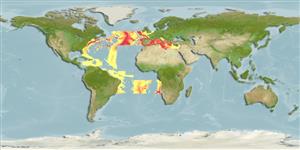Common names from other countries
Environment: milieu / climate zone / depth range / distribution range
Ecologie
Pelagisch; diepteverspreiding 0 - 4332 m (Ref. 106098). Temperate; 53°N - 22°S, 82°W - 37°E (Ref. 106965)
Atlantic, Gulf of Mexico, the Caribbean and the Mediterranean Sea.
Length at first maturity / Size / Gewicht / Leeftijd
Maturity: Lm ? range ? - ? cm Max length : 20.0 cm ML mannelijk/geslacht niet bekend; (Ref. 104052)
Mainly feeds on osteichthyes (myctophids), followed by crustaceans (natantian), and occasionally on cephalopods. Bases their diet on pelagic nictemeral migrators (Ref. 106992).
Life cycle and mating behavior
Geslachtsrijpheid | Voortplanting | Kuitschieten | Eieren | Fecundity | Larven
Members of the class Cephalopoda are gonochoric. Male and female adults usually die shortly after spawning and brooding, respectively. Mating behavior: Males perform various displays to attract potential females for copulation. During copulation, male grasp the female and inserts the hectocotylus into the female's mantle cavity where fertilization usually occurs. Life cycle: Embryos hatch into planktonic stage and live for some time before they grow larger and take up a benthic existence as adults.
Collins, M.A., C. Yau, L. Allcock and M.H. Thurston. 2001. (Ref. 1985)
Status op de Rode Lijst van het IUCN (Ref. 130435)
Status bij CITES (Ref. 108899)
Not Evaluated
Not Evaluated
Gebruik door de mens
| FishSource |
Tools
Internet-bronnen
Estimates based on models
Preferred temperature
(Ref.
115969): 4.8 - 13.9, mean 13.2 (based on 271 cells).
